What'sNEW April–May 2010
 J. Craig Venter J. Craig Venter |
 31 May 2010 31 May 2010
Nature asked eight synthetic-biology experts about the implications for science and society of the "synthetic cell" made by the J. Craig Venter Institute, reported online by Science.
 "Life after the synthetic cell" [html], doi:10.1038/465422a, p 422-424 v465, Nature, 27 May 2010. "Life after the synthetic cell" [html], doi:10.1038/465422a, p 422-424 v465, Nature, 27 May 2010.
 "Challenges of our own making" [html], doi:10.1038/465397a, p397 v465, Nature, 27 May 2010. "Challenges of our own making" [html], doi:10.1038/465397a, p397 v465, Nature, 27 May 2010.
 Daniel G. Gibson et al., "Creation of a Bacterial Cell Controlled by a Chemically Synthesized Genome", doi:10.1126/science.1190719, p52-56 v329, Science, 2 Jul (online 20 May) 2010. Daniel G. Gibson et al., "Creation of a Bacterial Cell Controlled by a Chemically Synthesized Genome", doi:10.1126/science.1190719, p52-56 v329, Science, 2 Jul (online 20 May) 2010.
 2 Jul 2010: Gabriel Manzotti points us to "Intergalactic legacy," by Chandra Wickramasinghe, connecting Venter's project to panspermia. 2 Jul 2010: Gabriel Manzotti points us to "Intergalactic legacy," by Chandra Wickramasinghe, connecting Venter's project to panspermia.
 Thanks, Stan Franklin. Thanks, Stan Franklin.
 24 May 2010 24 May 2010
 The SPIE Astrobiology Conference will again be in San Diego, CA, in early August. This year's chairs are Richard B. Hoover, NASA Marshall Space Flight Center; Gilbert V. Levin, Arizona State University; Alexei Yu. Rozanov, Paleontological Institute (Russian Federation); and Paul C. W. Davies, Arizona State University For the first time in our memory, Nobel laureate Charles Townes will participate in the Tuesday evening panel discussion that is a regular feature of this conference.
The SPIE Astrobiology Conference will again be in San Diego, CA, in early August. This year's chairs are Richard B. Hoover, NASA Marshall Space Flight Center; Gilbert V. Levin, Arizona State University; Alexei Yu. Rozanov, Paleontological Institute (Russian Federation); and Paul C. W. Davies, Arizona State University For the first time in our memory, Nobel laureate Charles Townes will participate in the Tuesday evening panel discussion that is a regular feature of this conference.
 Instruments, Methods, and Missions for Astrobiology XIII, San Diego, CA, 3-5 Aug 2010. Instruments, Methods, and Missions for Astrobiology XIII, San Diego, CA, 3-5 Aug 2010.
 20 May 2010 20 May 2010
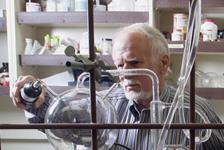 A conversation with Jeffrey L. Bada, a prominent origin-of-life researcher at the University of California, San Diego, is available in transcript. It is intriguing to learn more about Stanley Miller's lab vials that were stored in a cardboard box and almost forgotten for over fifty years (unprotected by the stringent anti-contamination protocols that would be required nowadays.) Also, Bada now believes that DNA-based life appeared about a billion years after Earth formed, and he is sure that amino acids in meteorites were produced by pre-biotic chemistry. But our main concern with all origin-of-life research is the elephant in the room, the software problem.
A conversation with Jeffrey L. Bada, a prominent origin-of-life researcher at the University of California, San Diego, is available in transcript. It is intriguing to learn more about Stanley Miller's lab vials that were stored in a cardboard box and almost forgotten for over fifty years (unprotected by the stringent anti-contamination protocols that would be required nowadays.) Also, Bada now believes that DNA-based life appeared about a billion years after Earth formed, and he is sure that amino acids in meteorites were produced by pre-biotic chemistry. But our main concern with all origin-of-life research is the elephant in the room, the software problem.
 Claudia Dreifus, "A Marine Chemist Studies How Life Began" [html], pD2, The New York Times, 18 Apr 2010. Claudia Dreifus, "A Marine Chemist Studies How Life Began" [html], pD2, The New York Times, 18 Apr 2010.
 Residue from one of Stanley Miller's experiments... is a related What'sNEW article, 20 Oct 2008. Residue from one of Stanley Miller's experiments... is a related What'sNEW article, 20 Oct 2008.
 Today, we still do not fully understand... is a What'sNEW article with more about Bada, 22 Apr 2005. Today, we still do not fully understand... is a What'sNEW article with more about Bada, 22 Apr 2005.
 The RNA World is the main local webpage about origin-of-life theories, including Bada's. The RNA World is the main local webpage about origin-of-life theories, including Bada's.
 Computer Models of Evolution is one of several local webpages about the software problem. Computer Models of Evolution is one of several local webpages about the software problem.
 Thanks, Kenneth B. Miller. Thanks, Kenneth B. Miller.
A brief history of panspermia that includes unfamiliar names, like Benoît De Maillet is available:
 Milton Wainwright and Fawaz Alshammari, "The Forgotten History of Panspermia and Theories of Life From Space," May 2010. Milton Wainwright and Fawaz Alshammari, "The Forgotten History of Panspermia and Theories of Life From Space," May 2010.
 12 May 2010 12 May 2010
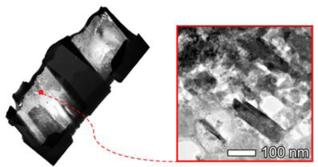 Past life on Mars is still the best explanation for the fossils in ALH84001, according to the NASA team that first made the claim about this meteorite in 1996. Their latest work, including probing chemical analyses of grains in the meteorite, was reported at the Astrobology Science Conference in Texas, 26-29 April.
Past life on Mars is still the best explanation for the fossils in ALH84001, according to the NASA team that first made the claim about this meteorite in 1996. Their latest work, including probing chemical analyses of grains in the meteorite, was reported at the Astrobology Science Conference in Texas, 26-29 April.
 K. L. Thomas-Keprta et al., "New Insights into the Origin of Magnetite Crystals in ALH84001 Carbonate Disks" [5102.pdf], Astrobiology Science Conference, 26 Apr 2010. K. L. Thomas-Keprta et al., "New Insights into the Origin of Magnetite Crystals in ALH84001 Carbonate Disks" [5102.pdf], Astrobiology Science Conference, 26 Apr 2010.
 Everett K. Gibson et al., "Early Mars: A warm wet niche for Life" [5062.pdf], Astrobiology Science Conference, 29 Apr 2010. Everett K. Gibson et al., "Early Mars: A warm wet niche for Life" [5062.pdf], Astrobiology Science Conference, 29 Apr 2010.
 Marc Kaufman, "NASA team cites new evidence that meteorites from Mars contain ancient fossils" [html], The Washington Post, 4 May 2010. Marc Kaufman, "NASA team cites new evidence that meteorites from Mars contain ancient fossils" [html], The Washington Post, 4 May 2010.
 Life on Mars! is the related local webpage. Life on Mars! is the related local webpage.
 Thanks, Larry Klaes. Thanks, Larry Klaes.
 10 May 2010 10 May 2010
Extraterrestrial life exists and there's evidence to prove it. So reads a banner on the back cover of We Are Not Alone, a new book by an American astrobiologist and British science writer.

Almost half the book deals with the case for life on Mars, including two chapters about the Viking probes, whose seemingly-conflicting results are fully discussed. A new resolution to the Viking puzzle would require microbial life with an unusual yet credible metabolism, the writers suggest. (But the difference between speculative hypotheses and generally accepted, conservative science is clear throughout the book.) The Mars section also has chapters on the Allen Hills meteorite, water on Mars, and Phoenix and future Mars missions.
Subsequent chapters consider evidence for life or past life on Venus, Europa and other moons, and especially, Titan, where "a separate origin of life would be almost guaranteed because of the extreme unlikelihood of organisms being transported on meteorites between the inner and outer solar system." But this opinion ignores the possibility that water-dependent, carbon-based life is widely distributed in the universe, as we believe. Naturally, we found a few items like this to disagree about. And the pledge of allegiance to darwinism (p 170) seems out of place; was it required to satisfy the orthodoxy committee?
However, there was much more that we like, beginning with the conclusion about Mars: "We believe that the Viking landers found life on Mars and that more recent evidence, especially from Martian meteorites and the discovery of methane on the Red Planet, strongly supports this claim." In general, we welcome the writers' attention to the wide range of issues pertaining to astrobiology, including insights about future missions. The book is well-organized, well-written and appropriately-illustrated. Moreover it is informative, imaginative, and, we think, persuasive. Highly recommended!
 Dirk Schulze-Makuch and David Darling, We Are Not Alone: Why We Have Already Found Extraterrestrial Life, Oneworld Publications, Mar 2010. Dirk Schulze-Makuch and David Darling, We Are Not Alone: Why We Have Already Found Extraterrestrial Life, Oneworld Publications, Mar 2010.
 Introduction: More Than Panspermia is a related local webpage. Introduction: More Than Panspermia is a related local webpage.
 Life on Mars! has more about the Viking missions and the Allen Hills meteorite. Life on Mars! has more about the Viking missions and the Allen Hills meteorite.
 Life on Europa, Other Moons, Other Planets? has links about Titan and other worlds where life may exist. Life on Europa, Other Moons, Other Planets? has links about Titan and other worlds where life may exist.
 2 May 2010 2 May 2010
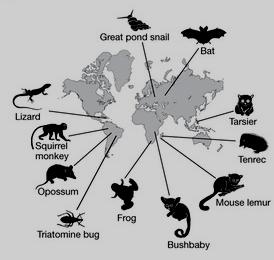 Transposable elements spread between disparate species by hitch-hiking in the genomes of parasites shared by these species, according to new research from The University of Texas at Arlington. Interestingly, the horizontal transfers revealed by this study apparently happened worldwide, even in South America before the Isthmus of Panama connected it to North America.
Transposable elements spread between disparate species by hitch-hiking in the genomes of parasites shared by these species, according to new research from The University of Texas at Arlington. Interestingly, the horizontal transfers revealed by this study apparently happened worldwide, even in South America before the Isthmus of Panama connected it to North America. After transfer, transposable elements multiply and disperse in the genome, with a range of effects mostly unexplored. We suggest that they are part of the genomic software management system required for cosmic ancestry. In any case, the research team, headed by Cédric Feschotte, concludes,
...The sheer amount of DNA generated by the amplification of the transposons and the myriad ways through which mobile elements can alter the structure and function of genomes support the idea that the exchange of genetic material between host and parasite species could strongly affect genome evolution.
 Clément Gilbert et al., "A role for host-parasite interactions in the horizontal transfer of transposons across phyla" [abstract], doi:10.1038/nature08939, p1347-1350 v464, Nature, 29 Apr 2010. Clément Gilbert et al., "A role for host-parasite interactions in the horizontal transfer of transposons across phyla" [abstract], doi:10.1038/nature08939, p1347-1350 v464, Nature, 29 Apr 2010.
 Scientists uncover transfer of genetic material between blood-sucking insect and mammals, The University of Texas at Arlington, 29 Apr 2010. Scientists uncover transfer of genetic material between blood-sucking insect and mammals, The University of Texas at Arlington, 29 Apr 2010.
 Viruses and Other Gene Transfer Mechanisms is the main related local webpage. Viruses and Other Gene Transfer Mechanisms is the main related local webpage.
What'sNEW about HGT  | |
 Thanks, Cody Bennett, again! Thanks, Cody Bennett, again!
 1 May 2010 1 May 2010
Phylogenetic analyses imply the ancestral transfer of these genes from a fungus to an ancestor of numerous modern aphid species. This sentence comes from a meticulous study by two biochemists at the University of Arizona.

Arrangement of the carotenoid biosynthetic genes (A) in the A. pisum (aphid) genome and (B) in the genome of the fungus Blakeslea trispora. Genes are represented by block arrows with blue for untranslated regions, grey for introns. Exons of carotenoid desaturase genes are red, exons of phytoene synthase/carotenoid cyclase genes are orange, and exons of other genes are green. (Figure and caption adapted from Moran and Jarvik, 2010.) |
According to darwinism, genes are supposed to be originally composed by mutation-and-selection. However, in spite of massive, worldwide genomic research, there are few or no convincing examples of such darwinian de novo composing. We think this lack is a crisis for strict darwinism. Meanwhile, examples of horizontal gene transfer (HGT) are piling up. If HGT provides genes with macroevolutionary benefits to aphids, from fungi, the surprise is ongoing. We think this trend points to a way out of the crisis.
 Nancy A. Moran and Tyler Jarvik, "Lateral Transfer of Genes from Fungi Underlies Carotenoid Production in Aphids", doi:10.1126/science.1187113, p624-627 v328, Science, 30 Apr 2010. Nancy A. Moran and Tyler Jarvik, "Lateral Transfer of Genes from Fungi Underlies Carotenoid Production in Aphids", doi:10.1126/science.1187113, p624-627 v328, Science, 30 Apr 2010.
 Takema Fukatsu, "A Fungal Past to Insect Color", doi:10.1126/science.1187113, p574-575 v328, Science, 30 Apr 2010. Takema Fukatsu, "A Fungal Past to Insect Color", doi:10.1126/science.1187113, p574-575 v328, Science, 30 Apr 2010.
 ...First Case of Animals Making Their Own Carotene, Mari N. Jensen, The University of Arizona, 29 Apr 2010. ...First Case of Animals Making Their Own Carotene, Mari N. Jensen, The University of Arizona, 29 Apr 2010.
 Viruses and Other Gene Transfer Mechanisms is a related local webpage. Viruses and Other Gene Transfer Mechanisms is a related local webpage.
What'sNEW about HGT  | |
 Thanks, Cody Bennett. Thanks, Cody Bennett.
 1 May 2010 1 May 2010
 A dual-function gene is very old according to a pair of German microbiologists who studied thermophylic prokaryotes for clues about the origin of life. They found that virtually all archaeal groups as well as the deeply branching bacterial lineages contain [an enzyme] ...with both FBP aldolase and FBP phosphatase activity. They further note, the bifunctional enzyme can be converted by only two mutations into a pure FBP aldolase or FBP phosphatase. Such conversion, designated "subfunctionalization," can allow genes to become specialized. Coupled with gene duplication, it can introduce a gene whose function may have been unexpressed on Earth before the duplication.
A dual-function gene is very old according to a pair of German microbiologists who studied thermophylic prokaryotes for clues about the origin of life. They found that virtually all archaeal groups as well as the deeply branching bacterial lineages contain [an enzyme] ...with both FBP aldolase and FBP phosphatase activity. They further note, the bifunctional enzyme can be converted by only two mutations into a pure FBP aldolase or FBP phosphatase. Such conversion, designated "subfunctionalization," can allow genes to become specialized. Coupled with gene duplication, it can introduce a gene whose function may have been unexpressed on Earth before the duplication.
| The huge impact of lateral gene transfer, often unrecognized, on prokaryote genome evolution has been impressively documented — Say and Fuchs | |
To explain the distribution of this gene the Germans conclude that it may have been (a) widely distributed but subsequently lost in most lineages, or (b) originally peculiar to Archaea and transferred, very early, twice, to Bacteria. Evidence that explains how it originated is not mentioned. The gene is just already there in the oldest evidence.
We remark, for what it's worth — Subfunctionalization is compatible with both cosmic ancestry and strict darwinism, but it does not compose programs for new functions. Horizontal gene transfer (HGT) is a basic prediction of cosmic ancestry, but surprising to darwinism. Genes with no apparent origin are the rule in cosmic ancestry, and mysterious in darwinism.
 Rafael F. Say and Georg Fuchs, "Fructose 1,6-bisphosphate aldolase/phosphatase may be an ancestral gluconeogenic enzyme" [abstract], doi:10.1038/nature08884, p1077-1081 v464, Nature, 15 Apr 2010. Rafael F. Say and Georg Fuchs, "Fructose 1,6-bisphosphate aldolase/phosphatase may be an ancestral gluconeogenic enzyme" [abstract], doi:10.1038/nature08884, p1077-1081 v464, Nature, 15 Apr 2010.
 Viruses and Other Gene Transfer Mechanisms is a related local webpage. Viruses and Other Gene Transfer Mechanisms is a related local webpage.
What'sNEW about HGT  | |
 Metazoan Genes Older Than Metazoa? is a related local webpage. Metazoan Genes Older Than Metazoa? is a related local webpage.
 Duplication... is a related webpage with discussion and links about subfunctionalization. Duplication... is a related webpage with discussion and links about subfunctionalization.
 28 April 2010 28 April 2010
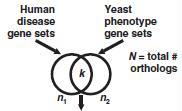 The conserved gene systems revealed by the plant-vertebrate phenologs illustrate a more ancient homology than the 'deep homology' of metazoans that is currently a focus of evolutionary developmental biology (evo-devo). This observation comes from an investigation of genetically-based human diseases by a collaboration between The Howard Hughes Medical Institute and The University of Texas. The investigation showed that yeast cells have genes that can direct the growth of human blood vessels! Also, genes that help plants steer their growth vertically may also direct cell migration and differentiation in developing animal embryos, and other plant genes are associated with deafness in humans. These and other surprises prompted Texas investigator Edward M. Marcotte (pictured) to comment, On the face of it, it's just crazy. The conserved gene systems revealed by the plant-vertebrate phenologs illustrate a more ancient homology than the 'deep homology' of metazoans that is currently a focus of evolutionary developmental biology (evo-devo). This observation comes from an investigation of genetically-based human diseases by a collaboration between The Howard Hughes Medical Institute and The University of Texas. The investigation showed that yeast cells have genes that can direct the growth of human blood vessels! Also, genes that help plants steer their growth vertically may also direct cell migration and differentiation in developing animal embryos, and other plant genes are associated with deafness in humans. These and other surprises prompted Texas investigator Edward M. Marcotte (pictured) to comment, On the face of it, it's just crazy.
In cosmic ancestry, life uses a toolkit of genes that are very (very) old. Delivered by horizontal gene transfer (HGT), acquired genes may sometimes wind up where they are irrelevant or harmful. But other times they would supply the programs needed for evolutionary advances.
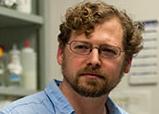
 Kriston L. McGary, Tae Joo Parka et al., "Systematic discovery of nonobvious human disease models through orthologous phenotypes" [abstract], doi:10.1073/pnas.091020010, p6544-6549 v107, Proc. Natl. Acad. Sci. USA, 6 Apr 2010. Kriston L. McGary, Tae Joo Parka et al., "Systematic discovery of nonobvious human disease models through orthologous phenotypes" [abstract], doi:10.1073/pnas.091020010, p6544-6549 v107, Proc. Natl. Acad. Sci. USA, 6 Apr 2010.
 Carl Zimmer, "The Search for Genes Leads to Unexpected Places" [html], pD1, The New York Times, 27 Apr 2010. Carl Zimmer, "The Search for Genes Leads to Unexpected Places" [html], pD1, The New York Times, 27 Apr 2010.
 Viruses and Other Gene Transfer Mechanisms is a related local webpage. Viruses and Other Gene Transfer Mechanisms is a related local webpage.
What'sNEW about HGT  | |
 Metazoan Genes Older Than Metazoa? is a local webpage with lots of examples of genes older than they should be. Metazoan Genes Older Than Metazoa? is a local webpage with lots of examples of genes older than they should be.
 Thanks, Peter Enyeart and Jeff Krolick. Thanks, Peter Enyeart and Jeff Krolick.
 24 April 2010 24 April 2010
...We have to keep an open mind about where life might be found in the universe. Ralph Lorenz of NASA's Cassini mission made this comment after the discovery that hardy fungi, bacteria and archaea can thrive in natural asphalt pools previously thought to be toxic to life. Titan (pictured), the huge moon of Saturn, has hydrocarbon lakes that might harbor similar ecologies.

 Dirk Schulze-Makuch et al., "Microbial Life in a Liquid Asphalt Desert" [abstract], arXiv:1004.2047v1, 12 Apr 2010. Dirk Schulze-Makuch et al., "Microbial Life in a Liquid Asphalt Desert" [abstract], arXiv:1004.2047v1, 12 Apr 2010.
 Toxic asphalt sludge is home to hardy microbes, NewScientist.com, 22 Apr 2010. Toxic asphalt sludge is home to hardy microbes, NewScientist.com, 22 Apr 2010.
 Bacteria: The Space Colonists is a related local webpage. Bacteria: The Space Colonists is a related local webpage.
 Life on Europa, Other Moons, Other Planets? has links about Titan and other worlds where life may exist. Life on Europa, Other Moons, Other Planets? has links about Titan and other worlds where life may exist.
 Thanks, Gabriel Manzotti and Jerry Chancellor. Thanks, Gabriel Manzotti and Jerry Chancellor.
 19 April 2010 19 April 2010
The extreme diversity and curious distribution of deep sea microbes are among the great mysteries of nature, and begs questions about the evolution of life on Earth. These words come from the Census of Marine Life, a collaboration of more than 2,000 scientists from 80+ nations. They report many surprises about microscopic life in the ocean:
 ...Estimates are now more than 1 billion microorganisms in a liter of seawater or a gram of seabed mud. ...Estimates are now more than 1 billion microorganisms in a liter of seawater or a gram of seabed mud.
 Microbial cells in the oceans' water column ...collectively weigh the equivalent of 240 billion African elephants. That's 35 elephants of marine microbes per person. Microbial cells in the oceans' water column ...collectively weigh the equivalent of 240 billion African elephants. That's 35 elephants of marine microbes per person.
 Responsible for more than 95 percent of respiration in the oceans, members of the microbe family maintain the planet's habitability. Their importance is hard to overstate. Responsible for more than 95 percent of respiration in the oceans, members of the microbe family maintain the planet's habitability. Their importance is hard to overstate.
 The total number of species of marine microbes, including both bacteria and archaea... is likely closer to a billion. The total number of species of marine microbes, including both bacteria and archaea... is likely closer to a billion.
 Many rare species in a sample stand opposite to a few species predominating. Wherever Census researchers looked they found many species in a sample represented by less than one in 10,000 of all individuals, including one-off singletons. Evidently many candidates, now rare, lie in wait to become dominant species if changes favor them. Many rare species in a sample stand opposite to a few species predominating. Wherever Census researchers looked they found many species in a sample represented by less than one in 10,000 of all individuals, including one-off singletons. Evidently many candidates, now rare, lie in wait to become dominant species if changes favor them.
This last surprise is especially interesting. It supports the supposition that major evolutionary steps depend on genetic programs that are available in the biosphere. Here we see that they could be already installed in separate species that are ready to thrive immediately.

 Explorers Inventory Hard-to-See Sea Life has links to the full newsrelease from the Census of Marine Life, 18 Apr 2010. Explorers Inventory Hard-to-See Sea Life has links to the full newsrelease from the Census of Marine Life, 18 Apr 2010.
 It's a microbial world by Jane Qiu, doi:10.1038/news.2010.190, NatureNews, 18 Apr 2010. It's a microbial world by Jane Qiu, doi:10.1038/news.2010.190, NatureNews, 18 Apr 2010.
 Gaia is a local webpage with more about how life could "maintain the planet's habitability." Gaia is a local webpage with more about how life could "maintain the planet's habitability."
 How is it Possible? is a local webpage suggesting that cosmic ancestry would logically comprise the widest variety of bacteria and archaea. That way, whatever environment were encountered, at least a few would be immediately ready to thrive. How is it Possible? is a local webpage suggesting that cosmic ancestry would logically comprise the widest variety of bacteria and archaea. That way, whatever environment were encountered, at least a few would be immediately ready to thrive.
 The deep sea is teeming with species that have never known sunlight, an earlier What'sNEW article about the Census of Marine Life, 22 Nov 2009. The deep sea is teeming with species that have never known sunlight, an earlier What'sNEW article about the Census of Marine Life, 22 Nov 2009.
 16 April 2010 16 April 2010
The Astrobiology Science Conference 2010 "is the next in a biennial series of meetings organized by the astrobiology community. The conference will convene scientists from all over the world who are working in the multidisciplinary field of astrobiology — the study of the origin, evolution, distribution, and future of life in the universe — to report on research findings and plan future endeavors. The theme for AbSciCon 2010 is Evolution and Life: Surviving Catastrophes and Extremes on Earth and Beyond." Only ten days away!

 Astrobiology Science Conference 2010, League City, TX, 26-29 Apr 2010. Astrobiology Science Conference 2010, League City, TX, 26-29 Apr 2010.
 15 April 2010 15 April 2010
 Germs we eat may supply genes to the microbes in our guts. Evidence for this supposition follows a metagenomic study by French and Canadian biologists who observed that the Japanese have gut bacteria with enzymes not found in the gut bacteria of North Americans. Further analysis revealed that the genes encoding those specialized enzymes are highly similar to genes found in certain marine bacteria that are associated with the seaweed (nori) that is a large part of the Japanese diet.
Germs we eat may supply genes to the microbes in our guts. Evidence for this supposition follows a metagenomic study by French and Canadian biologists who observed that the Japanese have gut bacteria with enzymes not found in the gut bacteria of North Americans. Further analysis revealed that the genes encoding those specialized enzymes are highly similar to genes found in certain marine bacteria that are associated with the seaweed (nori) that is a large part of the Japanese diet.
| Genes picked up from a microbial hitch-hiker may enable some Japanese individuals to extract otherwise intractable nutrients from seaweed. |
 "Dietary seaweed therefore is the most probable vector for the contact with marine microbes that led to HGT, as the only porphyran source in human nutrition is nori. Traditionally, nori is not roasted and thus contact with associated marine microbes is promoted through Japanese sushi...." "Dietary seaweed therefore is the most probable vector for the contact with marine microbes that led to HGT, as the only porphyran source in human nutrition is nori. Traditionally, nori is not roasted and thus contact with associated marine microbes is promoted through Japanese sushi...."
 "The detection of this HGT was possible owing to two favourable factors: Β-porphyranases are absent in terrestrial microbes, and the transfer was relatively recent compared to the millions of years of mammalian gut microbiome evolution." "The detection of this HGT was possible owing to two favourable factors: Β-porphyranases are absent in terrestrial microbes, and the transfer was relatively recent compared to the millions of years of mammalian gut microbiome evolution."
 "The results suggest that ingested bacteria may have provided a valuable genetic resource for gut microbes throughout human history...." "The results suggest that ingested bacteria may have provided a valuable genetic resource for gut microbes throughout human history...."
 Obviously, horizontal gene transfer (HGT) can be important for symbionts, too. Obviously, horizontal gene transfer (HGT) can be important for symbionts, too.
 Jan-Hendrik Hehemann et al., "Transfer of carbohydrate-active enzymes from marine bacteria to Japanese gut microbiota" [abstract | Editor's Summary], doi:10.1038/nature08937, p908-912 v464, Nature, 8 Apr 2010. Jan-Hendrik Hehemann et al., "Transfer of carbohydrate-active enzymes from marine bacteria to Japanese gut microbiota" [abstract | Editor's Summary], doi:10.1038/nature08937, p908-912 v464, Nature, 8 Apr 2010.
 Justin L. Sonnenburg, "...Genetic pot luck" [html], doi:10.1038/464837a, p837-838 v464, Nature, 8 Apr 2010. Justin L. Sonnenburg, "...Genetic pot luck" [html], doi:10.1038/464837a, p837-838 v464, Nature, 8 Apr 2010.
 Heidi Ledford, "A genetic gift for sushi eaters" [abstract], doi:10.1038/news.2010.169, Nature, online 7 Apr 2010. Heidi Ledford, "A genetic gift for sushi eaters" [abstract], doi:10.1038/news.2010.169, Nature, online 7 Apr 2010.
 Gut bacteria are what we eat by Jef Akst, TheScientist.com, 7 Apr 2010. Gut bacteria are what we eat by Jef Akst, TheScientist.com, 7 Apr 2010.
 Genes in the microbes in our guts.... is a related What'sNEW article, 5 Mar 2010. Genes in the microbes in our guts.... is a related What'sNEW article, 5 Mar 2010.
 Viruses and Other Gene Transfer Mechanisms is a related local webpage. Viruses and Other Gene Transfer Mechanisms is a related local webpage.
What'sNEW about HGT  | |
 Thanks, Jeff Holiman. Thanks, Jeff Holiman.
 11 April 2010 11 April 2010
Intelligent life beyond Earth may have left an encoded message in DNA. This is among the suggestions in a wide-ranging and informative article by Paul Davies of Arizona State University about the search for extraterrestrial intelligence (SETI). Davies thinks that an advanced civilization could have "uploaded the data into the junk DNA of terrestrial organisms." Of course, panspermia distributes DNA; does that count as "uploading"? In any case, we welcome his imaginative discussion of the topic in WSJ's weekend edition. We are less enthusiastic about the comicbook illustrations.

 Paul Davies, "Is Anybody Out There?" [link], p W1-W2, The Wall Street Journal, 10-11 Apr 2010. Paul Davies, "Is Anybody Out There?" [link], p W1-W2, The Wall Street Journal, 10-11 Apr 2010.
 Chris McKay, "Is Anybody Out There?" (review of Davies' book The Eerie Silence) [html], Nature, 4 Mar 2010. Chris McKay, "Is Anybody Out There?" (review of Davies' book The Eerie Silence) [html], Nature, 4 Mar 2010.
 How is it Possible? is a related local webpage. How is it Possible? is a related local webpage.
 Thanks, Mom and Clint Pearson. Thanks, Mom and Clint Pearson.
 9 April 2010 9 April 2010
How life might travel through space is one of the questions addressed by Dr. Alan Tunnacliffe (pictured) of the Institute of Biotechnology at Cambridge University. He studies life's capability to survive harsh conditions including drying, extreme temperatures and pressures, and intense radiation. In a short video he shows tiny rotifers reviving after exposure to such extremes.

 Just Add Water, 5:45 minute YouTube video from Cambridge University, 6 Apr 2010. Just Add Water, 5:45 minute YouTube video from Cambridge University, 6 Apr 2010.
 Introduction: More Than Panspermia is a related local webpage. Introduction: More Than Panspermia is a related local webpage.
 Bdelloid rotifers have unusual properties is a related What'sNEW article, 25 Mar 2008. Bdelloid rotifers have unusual properties is a related What'sNEW article, 25 Mar 2008.
 Thanks, Google Alerts. Thanks, Google Alerts.
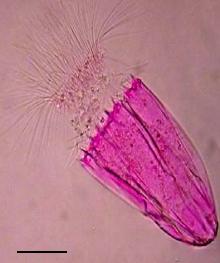 Spinoloricus nov. sp. (Loricifera). scale bar = 50 μm Spinoloricus nov. sp. (Loricifera). scale bar = 50 μm |
 8 April 2010 8 April 2010
Multicelled animals live and multiply without oxygen in the deep ocean. A team from the Polytechnic University of Marche, Ancona, Italy, discovered them in anoxic, sulfidic sediments 3,000 meters underwater in the Atalante basin of the Mediterranean Sea. The observed animals are designated as three new species in the Loricifera phylum, but their cells lack the mitochondria that supply energy in most eukaryotes. Instead they have organelles resembling the hydrogenosomes found in anaerobic microbes. Commentators are suggesting that such species may have been far more plentiful when Earth had little free oxygen. We think animals like them might live in anoxic oceans on other worlds as well.
 Roberto Danovaro et al., "The first metazoa living in permanently anoxic conditions" [abstract], doi:10.1186/1741-7007-8-30, BMC Biology, 6 Apr 2010. Roberto Danovaro et al., "The first metazoa living in permanently anoxic conditions" [abstract], doi:10.1186/1741-7007-8-30, BMC Biology, 6 Apr 2010.
 First animals to live without oxygen discovered, EurekAlert, 7 Apr 2010. First animals to live without oxygen discovered, EurekAlert, 7 Apr 2010.
 ...Animals That Live Without Oxygen by Gretchen Vogel, ScienceNow, 7 Apr 2010. ...Animals That Live Without Oxygen by Gretchen Vogel, ScienceNow, 7 Apr 2010.
 Animals thrive without oxygen at sea bottom by Janet Fang, doi:10.1038/464825b, p825 v464, Nature, online 6 Apr 2010. Animals thrive without oxygen at sea bottom by Janet Fang, doi:10.1038/464825b, p825 v464, Nature, online 6 Apr 2010.
 Life on Europa, Other Moons, Other Planets? has links about other worlds where life may exist. Life on Europa, Other Moons, Other Planets? has links about other worlds where life may exist.
 Thanks, Stan Franklin. Thanks, Stan Franklin.
 3 April 2010 3 April 2010
Whole chromosomes can be horizontally transferred into reproductively isolated strains of fungi. So reports an international team studying the Fusarium genus of fungi whose different species cause various diseases in plants. One species, F. oxysporum, has four chromosomes that other members of the genus lack. These "lineage specific" (LS) chromosomes are rich in transposable elements, and the F. oxysporum genome contains ~40 to ~60 times more repetitive elements than two reference species. The geneticists surmised that the LS chromosomes were acquired by transfer. They then asked whether the transfer of whole chromosomes between genetically isolated strains of these fungi could be demonstrated. It was demonstrated, and the related phenotypic differences were expressed.
 "Experimentally, we have demonstrated the transfer of entire LS chromosomes through simple co-incubation between two otherwise genetically isolated members of [F. oxysporum].... Spontaneous horizontal transfer of such a large portion of a genome and the direct demonstration of associated transfer of host-specific pathogenicity has not been previously reported."
"Experimentally, we have demonstrated the transfer of entire LS chromosomes through simple co-incubation between two otherwise genetically isolated members of [F. oxysporum].... Spontaneous horizontal transfer of such a large portion of a genome and the direct demonstration of associated transfer of host-specific pathogenicity has not been previously reported."
Horizontal gene transfer (HGT) can quickly and powerfully affect evolution. In darwinian theory this capability is a surprise that gets scant attention. In cosmic ancestry HGT is not surprising but essential. Now we see that some fungi (eukaryotes!) can acquire whole chromosomes, ready for immediate use. Wow.
 Li-Jun Ma, H. Charlotte van der Does et al., "Comparative genomics reveals mobile pathogenicity chromosomes in Fusarium" [abstract], doi:10.1038/nature08850, p367-373 v464, Nature, 18 Mar 2010. Li-Jun Ma, H. Charlotte van der Does et al., "Comparative genomics reveals mobile pathogenicity chromosomes in Fusarium" [abstract], doi:10.1038/nature08850, p367-373 v464, Nature, 18 Mar 2010.
 Fungi can change quickly, pass along infectious ability, Oregon State University, 17 Mar 2010. Fungi can change quickly, pass along infectious ability, Oregon State University, 17 Mar 2010.
 Viruses and Other Gene Transfer Mechanisms is a related local webpage. Viruses and Other Gene Transfer Mechanisms is a related local webpage.
What'sNEW about HGT  | |
|
 The SPIE Astrobiology Conference will again be in San Diego, CA, in early August. This year's chairs are Richard B. Hoover, NASA Marshall Space Flight Center; Gilbert V. Levin, Arizona State University; Alexei Yu. Rozanov, Paleontological Institute (Russian Federation); and Paul C. W. Davies, Arizona State University For the first time in our memory, Nobel laureate Charles Townes will participate in the Tuesday evening panel discussion that is a regular feature of this conference.
The SPIE Astrobiology Conference will again be in San Diego, CA, in early August. This year's chairs are Richard B. Hoover, NASA Marshall Space Flight Center; Gilbert V. Levin, Arizona State University; Alexei Yu. Rozanov, Paleontological Institute (Russian Federation); and Paul C. W. Davies, Arizona State University For the first time in our memory, Nobel laureate Charles Townes will participate in the Tuesday evening panel discussion that is a regular feature of this conference. A conversation with Jeffrey L. Bada, a prominent origin-of-life researcher at the University of California, San Diego, is available in transcript. It is intriguing to learn more about Stanley Miller's lab vials that were stored in a cardboard box and almost forgotten for over fifty years (unprotected by the stringent anti-contamination protocols that would be required nowadays.) Also, Bada now believes that DNA-based life appeared about a billion years after Earth formed, and he is sure that amino acids in meteorites were produced by pre-biotic chemistry. But our main concern with all origin-of-life research is the elephant in the room, the software problem.
A conversation with Jeffrey L. Bada, a prominent origin-of-life researcher at the University of California, San Diego, is available in transcript. It is intriguing to learn more about Stanley Miller's lab vials that were stored in a cardboard box and almost forgotten for over fifty years (unprotected by the stringent anti-contamination protocols that would be required nowadays.) Also, Bada now believes that DNA-based life appeared about a billion years after Earth formed, and he is sure that amino acids in meteorites were produced by pre-biotic chemistry. But our main concern with all origin-of-life research is the elephant in the room, the software problem. Past life on Mars is still the best explanation for the fossils in ALH84001, according to the NASA team that first made the claim about this meteorite in 1996. Their latest work, including probing chemical analyses of grains in the meteorite, was reported at the Astrobology Science Conference in Texas, 26-29 April.
Past life on Mars is still the best explanation for the fossils in ALH84001, according to the NASA team that first made the claim about this meteorite in 1996. Their latest work, including probing chemical analyses of grains in the meteorite, was reported at the Astrobology Science Conference in Texas, 26-29 April.



 Transposable elements spread between disparate species by hitch-hiking in the genomes of parasites shared by these species, according to new research from The University of Texas at Arlington. Interestingly, the horizontal transfers revealed by this study apparently happened worldwide, even in South America before the Isthmus of Panama connected it to North America.
Transposable elements spread between disparate species by hitch-hiking in the genomes of parasites shared by these species, according to new research from The University of Texas at Arlington. Interestingly, the horizontal transfers revealed by this study apparently happened worldwide, even in South America before the Isthmus of Panama connected it to North America.
 A dual-function gene is very old according to a pair of German microbiologists who studied thermophylic prokaryotes for clues about the origin of life. They found that virtually all archaeal groups as well as the deeply branching bacterial lineages contain [an enzyme] ...with both FBP aldolase and FBP phosphatase activity. They further note, the bifunctional enzyme can be converted by only two mutations into a pure FBP aldolase or FBP phosphatase. Such conversion, designated "subfunctionalization," can allow genes to become specialized. Coupled with gene duplication, it can introduce a gene whose function may have been unexpressed on Earth before the duplication.
A dual-function gene is very old according to a pair of German microbiologists who studied thermophylic prokaryotes for clues about the origin of life. They found that virtually all archaeal groups as well as the deeply branching bacterial lineages contain [an enzyme] ...with both FBP aldolase and FBP phosphatase activity. They further note, the bifunctional enzyme can be converted by only two mutations into a pure FBP aldolase or FBP phosphatase. Such conversion, designated "subfunctionalization," can allow genes to become specialized. Coupled with gene duplication, it can introduce a gene whose function may have been unexpressed on Earth before the duplication.
 The conserved gene systems revealed by the plant-vertebrate phenologs illustrate a more ancient homology than the 'deep homology' of metazoans that is currently a focus of evolutionary developmental biology (evo-devo). This observation comes from an investigation of genetically-based human diseases by a collaboration between The Howard Hughes Medical Institute and The University of Texas. The investigation showed that yeast cells have genes that can direct the growth of human blood vessels! Also, genes that help plants steer their growth vertically may also direct cell migration and differentiation in developing animal embryos, and other plant genes are associated with deafness in humans. These and other surprises prompted Texas investigator Edward M. Marcotte (pictured) to comment, On the face of it, it's just crazy.
The conserved gene systems revealed by the plant-vertebrate phenologs illustrate a more ancient homology than the 'deep homology' of metazoans that is currently a focus of evolutionary developmental biology (evo-devo). This observation comes from an investigation of genetically-based human diseases by a collaboration between The Howard Hughes Medical Institute and The University of Texas. The investigation showed that yeast cells have genes that can direct the growth of human blood vessels! Also, genes that help plants steer their growth vertically may also direct cell migration and differentiation in developing animal embryos, and other plant genes are associated with deafness in humans. These and other surprises prompted Texas investigator Edward M. Marcotte (pictured) to comment, On the face of it, it's just crazy.



 Germs we eat may supply genes to the microbes in our guts. Evidence for this supposition follows a metagenomic study by French and Canadian biologists who observed that the Japanese have gut bacteria with enzymes not found in the gut bacteria of North Americans. Further analysis revealed that the genes encoding those specialized enzymes are highly similar to genes found in certain marine bacteria that are associated with the seaweed (nori) that is a large part of the Japanese diet.
Germs we eat may supply genes to the microbes in our guts. Evidence for this supposition follows a metagenomic study by French and Canadian biologists who observed that the Japanese have gut bacteria with enzymes not found in the gut bacteria of North Americans. Further analysis revealed that the genes encoding those specialized enzymes are highly similar to genes found in certain marine bacteria that are associated with the seaweed (nori) that is a large part of the Japanese diet.

 "Experimentally, we have demonstrated the transfer of entire LS chromosomes through simple co-incubation between two otherwise genetically isolated members of [F. oxysporum].... Spontaneous horizontal transfer of such a large portion of a genome and the direct demonstration of associated transfer of host-specific pathogenicity has not been previously reported."
"Experimentally, we have demonstrated the transfer of entire LS chromosomes through simple co-incubation between two otherwise genetically isolated members of [F. oxysporum].... Spontaneous horizontal transfer of such a large portion of a genome and the direct demonstration of associated transfer of host-specific pathogenicity has not been previously reported."